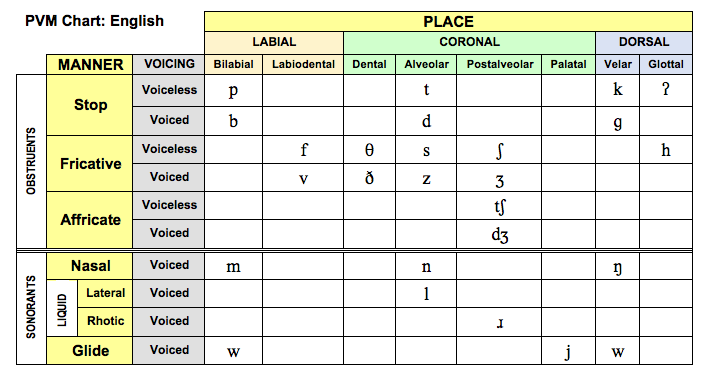* RESOURCES INDEX
- Details
- Created: Friday, 28 October 2011 15:34
- Updated on Tuesday, 24 November 2020 13:29
This is the RESOURCES INDEX.
Scroll down for child speech assessment and intervention resources, and CPD links, articles and information.
The intervention resources include Singleton Consonant and Consonant Cluster pictures, Vowel pictures and vowel contrasts, Consonant Minimal Pair pictures, Near Minimal Pair pictures, and wordlists and worksheets based around facilitative articulatory contexts, nonlinear phonology, complexity principles and lexical properties.
There are also Slide Shows about the assessment of, and evidence-based intervention for, children's speech sound disorders.

Please consider donating to the upkeep of this site. THANK YOU!
Assessment Resources
-
Child Speech Assessment Resources
On this page you will find the ALPHA Test of Phonology; Clinically Useful Words; Speech Characteristics Rating Form; Stimulability Assessment; The Locke Speech Perception - Speech Production Task;The Quick Screener and The Quick Vowel Screener; and The Quick Screener for Teachers. -
Decision Tree: Which Treatment Approach to Use? - 1-page pdf
A flow chart from Peter Flipsen Jr PhD. -
Phonological Awareness Tests: Roslyn Neilson
Roslyn Neilson PhD has researched and developed three tests of phonological awareness. The tests may be administered by speech pathologists, psychologists and teachers. -
Phonotactic Assessment Prompt - 1-page pdf
A 1-page pdf to aid phonotactic assessment.
CPD - Links, Articles, Resources
-
Continuing Professional Development Resources
Alphabetical list of linked resources referred to in Continuing Professional Development (CPD) events with Caroline Bowen
Handout
Forms
These are links to the page that contains the forms. Go to the page and scroll down to find the ALPHA, Quick Screener, SCRF, and Stimulability forms.
- ALPHA Test of Phonology Forms
- Quick Screener Assessment Forms
- Speech Characteristics Rating Form
- Stimulability Assessment Form
Pictures
These are links to the pages that contain the pictures, not direct links to the pictures themselves. Click on the links below and scroll to the foot of the page to locate two sets of Einstein pictures and two versions of the Adele Miccio Character Cards for Stimulability Therapy, updated in 2012.
Slide Shows
These are links to the pages that contain the slide shows, not direct links to the slide shows themselves.
-
Adult Communicative Styles and Encouraging Reticent Children to Converse
This slide show is at the foot of the page. -
Dynamic Temporal and Tactile Cueing and Integral Stimulation (Look at me for help)
This slide show is immediately under the picture at the top of the page. -
How Jessica Learned to Say 'Yellow' (You're a star, Jessica!)
See Backward Chaining near the bottom of the page. -
How Max Learned to say "Leura Public"
See Successive Approximations at the bottom of the page. -
Josie and PACT Therapy
This slide show is under the heading "Slide Show and Web Page" -
Many Repeats - Drill For Beginning Beginners 'to make the words easy to say' (Andrew Bear; Andrew Bear and Boo)
These two slide shows are are near the bottom of the page. -
Metalinguistic Cues and Imagery slide show
This slide show is at the bottom of the page with a handout too. -
Minimal Pairs - Oh boy! It's a test!
This slide show is under heading #4. -
Modelling and Recasting / Frequent Recasting
These three slide shows are at the foot of the page. -
Non-speech Oral Motor Exercises and Other Controversial Practices in Children's Speech Sound Disorders
This slide show is at the foot of the page. -
PACT Summary and Examples of Multiple Exemplar Training activities
This slide show is at the foot of the page. -
Revisions and Repairs - The Fixed-up-one Routine
These two slide shows are under the heading "Slide Shows". -
Slide Show about Constructing and Administering the Locke Task
See Locke Task -
The Quick Screener (Screening test of phonology)
See "Quick Screener". -
Traditional Articulation Therapy
This slide show is near the bottom of the page immediately before the second picture. -
Treatment Principles: Phonological Disorder, CAS; and the Principles of Motor Learning
This slide show is near the top of the page, below the picture. -
The Quick Vowel Screener
See "Quick Vowel Screener".
Can't open the ppsx slide shows? Go to Slide Show Help
Word Lists
These are links to the pages that contain the word lists, and except for #6 and #7, not direct links to the word lists themselves.
-
Alveolars and high front vowels (word lists and pictures to use in intervention)
These word lists under "Phonological Tendencies & Reduplication". -
Final fricatives, velars and voiceless stops with short vowels
These word lists are under "Phonotactics - Syllable Structure" -
High Frequency /s/ SIWI and /s/ SFWF words
These /s/ words are listed on the web page - you don't need to download a pdf. -
Peter Flipsen Jr's Listening Lists
This pdf is under the heading "Listening Lists" -
Verbs, Nouns and Adjectives that Reside in Sparse Neighbourhoods (< 11 Neighbours)
These word lists are at the end of the section headed "Lexical Properties" -
Word Lists for Focused Auditory Input, Phonological Intervention, and Articulation Therapy
This is a direct link to the word lists page -
Minimal Pairs
This is a direct link to the minimal pairs page
Worksheets; Pictures and Words
These are links to the pages that contain the work sheets, not direct links to the work sheets themselves. Each work sheet is a pdf.
- How to make a worksheet to upload to the Internet
- Worksheets: Consonants, Clusters, Vowels
- Worksheets: Complexity; Lexical Properties, Markedness, SSP, Phonotactics, Facilitative Contexts
- Worksheets: Contrasts; Minimal Pairs; Near Minimal Pairs
- Worksheets: Maximal Oppositions (Minimal Pairs)
- Worksheets: Revisions and Repairs and the fixed-up-one routine
- Worksheets: Within Word ("Medial") Consonants
- Worksheets: Long Words
Terminology Used in the Worksheets
SIWI, SFWF, WIWW, SFW
In the branch of Clinical Linguistics called clinical phonology, the abbreviations SIWI, SFWF, SIWW and SFWW are used to describe where sounds occur in spoken words.
- SIWI is "syllable initial word initial". In the word "ball", /b/ is SIWI.
- SFWF is "syllable final word final". In the word "rub" /b/ is SFWF.
- SIWW is "syllable initial within word". In the word "about" /b/ is SIWW.
- SFWW is "syllable final within word". In the word "tablet" /b/ is SFWW.
The terms are used to denote how the words are pronounced by an individual, not the way you spell them, or the way they "should" be pronounced. So, for example, when you break a word like "innocent" into syllables with regard to how you might spell it you get inn-o-cent. But when most speakers of English SAY the word it becomes (roughly!) ih-nu-sent so that the /n/ is SIWW (not SFWW as it would be if you said in-uh-sent).
Many speech-language pathologists / speech and language therapists use these abbreviations when they look at "phonotactics" (the patterns of vowels and consonants, or syllable shapes a child can produce) in detail, as part of a phonological analysis. The information is useful in choosing therapy targets and devising word lists for production practice and auditory bombardment (focused auditory input) when appropriate.
Place-Voice-Manner Chart
Consonants are classified in terms of their place of articulation, manner of articulation and voicing. The chart below is a PVM Chart showing the consonants of English. The voiced glide /w/ is included twice because it has two places of articulation, bilabial and velar. The glottal stop is also there because it occurs in some varieties of English.

Place of Articulation
Consonants are made by obstructing or constricting airflow at some point in the vocal tract. The point of obstruction or constriction is called the place of articulation. The ‘places’ of articulation are Bilabial, Labiodental, Interdental, Alveolar, Palatal, Velar and Glottal. Note that there are other classification systems that differ slightly.
Manner of Articulation
Consonants are classified in terms of their Place-Manner-Voice. The manner of articulation is the type of obstruction that occurs in the production of a particular consonant. The ‘manners’ of articulation are: Stop, Fricative, Affricate, Nasal, Liquid and Glide. The Stops, Fricatives and Affricates are termed obstruents, and the Nasals, Liquids, Glides, AND VOWELS are termed sonorants. The consonants /l/, /r/, /w/ and /j/ are also referred to as approximants.
There are more definitions in the glossary.


